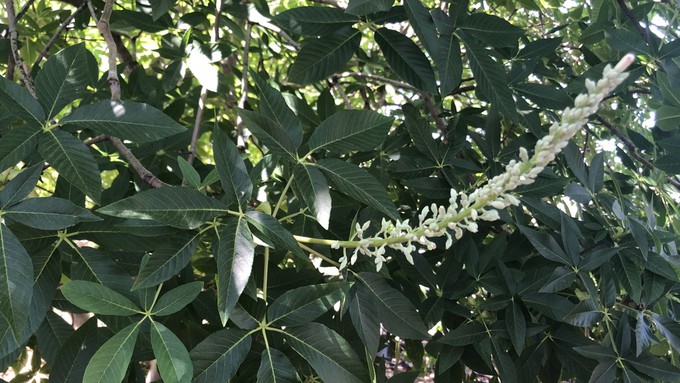
More native plants means more resources for native insects, pollinators and birds

This California buckeye (Aesculus californica) was photographed during the 2023 Gardens Gone Native tour. The flowers, when open, are popular with butterflies. Kathy Morrison
It's California Native Plant Week! The official event, sponsored by the California Native Plant Society, runs through Saturday. But even as we celebrate together our state's incredible biodiversity, we should make a point of doing so on an individual basis all year.
Here are some ideas for getting more natives into your garden and your community.
1. Don't know what to plant? Tour native gardens for ideas. Here are 3 regular tours:
-- Presented by the Sacramento Valley Chapter of the California Native Plant Society on Saturday, April 27, the annual Gardens Gone Native tour is free, and there's still time to sign up here. I've gotten all kinds of inspiration over the years from the Sacramento-area gardens in this tour. I also -- and this is important -- got advice from the host gardeners on what NOT to plant. Some natives, in good soil and receiving regular water, get too happy in a home garden and try to take over. Ask the hosts, they'll tell you!
-- The UC Davis Arboretum and Public Garden is packed with natives, all clearly labeled. Take a self-guided tour or sign up for a Wednesday Walk With Warren, a monthly tour with Warren Roberts, the superintendent emeritus of the arboretum. The next is May 8, noon to 1 p.m. Sign up here.
-- Take a ramble through Patricia Carpenter's native garden west of Davis. Carpenter, a CNPS Garden Ambassador, schedules seasonal open gardens, which are free but require registration. The 2024 Late Spring Ramble is set for 9 a.m. to 2 p.m. Sunday, May 19.
2. Befriend gardeners who grow native plants. Gardeners love to share plants, seeds and especially advice on what to grow and how. Find like-minded gardeners at the Sac Valley Chapter of CNPS; they meet the second Wednesday of each month (except July, August and December) at the Shepard Garden & Arts Center. Visit the Fair Oaks Horticulture Center during an Open Garden (next is May 11), and talk to the master gardeners in the Native Plant Garden.
3. Look for native plants and seeds at local nurseries and garden group plant sales. The Arboretum plant sales are ideal -- next one is April 27 -- as are the less-frequent CNPS and master gardener sales. (El Dorado County has natives in its next sale April 27.) But you can also find natives at locally owned nurseries such as The Plant Foundry and Green Acres.
4. Bookmark Calscape.org -- it's a great resource for checking names, habitats and wildlife host plants. Enter any address in the state and find out which plants are native to that area. Calscape also has an excellent garden planner function.
5. Love butterflies? How about birds? Advocate for native plants with friends, landscapers, whomever you talk to about plants. Raise awareness of native wildlife's need for native plants. Let neighbors know about the life cycle of native plants (many are dormant in summer).
6. Read up: "California Native Gardening: A Month-By-Month Guide" by Helen Popper is an excellent practical handbook. "California Bees & Blooms: A Guide for Gardeners and Naturalists" by Gordon W. Frankie, is another of my favorites. (California has more than 1,600 identified species of native bees.)
Here's an inspirational quote from the latter book:
"With the right bee plants, one small urban garden can attract 40 to 50 species. An act as simple as planting a few square feet of California poppies, phacelia, sage and other bee plants is enough to sustain diverse native bees and reclaim a small piece of California's lost bee-pastures."
Comments
0 comments have been posted.Sacramento Digs Gardening to your inbox.
Sites We Like
Garden Checklist for week of July 21
Your garden needs you!
* Keep your vegetable garden watered, mulched and weeded. Water before 8 a.m. to reduce the chance of fungal infection and to conserve moisture.
* Feed vegetable plants bone meal, rock phosphate or other fertilizers high in phosphate to stimulate more blooms and fruiting. (But wait until daily high temperatures drop out of the 100s.)
* Don’t let tomatoes wilt or dry out completely. Give tomatoes a deep watering two to three times a week.
* Harvest vegetables promptly to encourage plants to produce more. Squash especially tends to grow rapidly in hot weather. Keep an eye on zucchini.
* Pinch back chrysanthemums for bushy plants and more flowers in September.
* Remove spent flowers from roses, daylilies and other bloomers as they finish flowering.
* Pinch off blooms from basil so the plant will grow more leaves.
* Cut back lavender after flowering to promote a second bloom.
* It's not too late to add a splash of color. Plant petunias, snapdragons, zinnias and marigolds.
* From seed, plant corn, pumpkins, radishes, winter squash and sunflowers.